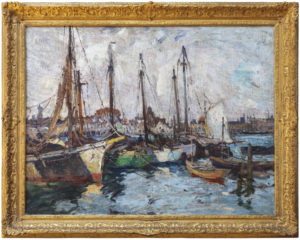
Harry Aiken Vincent
(1864-1931)
The more one reads about the life of artists, with a bit of historical perspective, the more one notices that pure talent and quality of output frequently does not correlate with the quantity of biographical material and critical writing that exists on that artist. Clearly, there is a realization that the personality of the artist himself is a factor, in addition to the quality of his or her work. Unquestionably, the exceptional quality of Harry Vincent’s mature work does not correlate with the modest amount of scholarly writing about him. One must conclude he was likely a reserved, perhaps even shy person who preferred to paint than to talk about it. Chicago-born and trained, little is known of his life prior to settling in Rockport, Massachusetts, in 1918. Apparently he was quickly recognized as a significant artist since, a short three years later, he was appointed the first acting president of the Rockport Art Association, formed in 1921. Probably best described as a painter’s painter, and an artist other artists respected, Vincent is generally considered largely self-taught. Over the years of piecing together many artists’ lives, I’ve formulated a sort-of philosophy that often self-taught artists are slower to evolve their ultimate style and can also be more experimental— which can translate into more “hit or miss” than highly trained academic artists. I feel that this applies to Vincent: his compositions are often very daring, unexpected, and seeking a discernibly different perspective than the majority of those artists around him. Of the major half-dozen Cape Ann artists of the early to mid–20th-century, Vincent was the last one whose work I saw, despite hearing his name often mentioned as one of the great ones. The first example I obtained was in 1984 from a gallery in Minnesota, entitled Wheeler’s Wharf. It reflects Vincent’s many painterly qualities. Gradually, more of the artist’s work began appearing on the market, and I located a street scene at Greenwich Galleries in 1996. Thanks to a phone call from the dealer Grier Clark a few years later, a very important example—and certainly among the very best two or three paintings I’ve ever seen—became available. This piece had been a gift to a retiring business executive in 1942 and represents the iconic Motif #1 from a distinctly unique perspective. A Blackwood March auction in 2000 was the source for a small coastal image. Then, in 2003, an interesting discovery turned up in an unlikely spot: a Chinese antique shop in Scottsdale, Arizona. I knew Vincent did works on paper but had seen only one or two watercolors, which had serious condition problems. But here among foo dogs and cloisonné vases was a true masterpiece of design and texture, a gouache that absolutely knocked me over; the Chinese dealer thought so too. It took a lot of negotiating and rationalizing to bring this piece into the collection. My last piece truly reflects Vincent’s daring compositional experiments in a painting entitled March, Rockport. It is fitting that this piece came from a Cape Ann dealer collector… in Vincent’s backyard, so to speak.